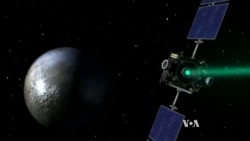NASA’s Dawn spacecraft is set to reach the dwarf planet Ceres in March and begin gathering clues about whether the icy body may have once had conditions conducive to supporting life.
Dawn left Earth more than seven years ago, on a course to explore two alien worlds in the solar system: Ceres and Vesta, both in the main asteroid belt between Mars and Jupiter.
“This is the first time in more than 57 years of space exploration that we have a spacecraft targeted to orbit any two extraterrestrial destinations,” said Dawn chief engineer and mission director Marc Rayman.
Vesta and Ceres are considered protoplanets. They were "in the process of growing to become full-size planets when their growth was terminated,” Rayman said.
At the Dawn mission control center in Los Angeles, the flight team sends second-by-second instructions to the spacecraft, directing its every move, including the images it takes of what it sees.
Scientists believe Ceres is made of rock covered with a mantle of ice. Dawn will take images and make a comprehensive map of this alien world. It will also examine Ceres’ composition to provide data on how its surface has evolved, said Carol Raymond, the mission's deputy principal investigator.
“One of the interests in bodies like Ceres and other icy bodies in the outer solar system is that when objects like that impacted the terrestrial planets, they brought a lot of water," she said. "So there’s a very vigorous debate at the current time as to whether wet asteroids like Ceres — and we know there are other wet asteroids in the outer edge of the main belt — whether they were the dominant source of water in the Earth’s ocean.”
Earlier in its mission, Dawn made an unexpected discovery while orbiting the protoplanet Vesta.
“Instead of being bone dry, which we expected, there were patches on the surface of Vesta that showed significant amounts of water bound in the rocks and possibly even free water that could have flowed on the surface in the past,” Raymond said.
Raymond said that if Earth’s water came from wet worlds like these, then life could have come with them as well.
If Dawn reveals that the environment on Ceres could be conducive to life, the finding may spur further explorations with other types of instruments to test that hypothesis.
As for Dawn, it will gather information on Ceres until the summer of 2016. Then it will continue to orbit the dwarf planet indefinitely.










